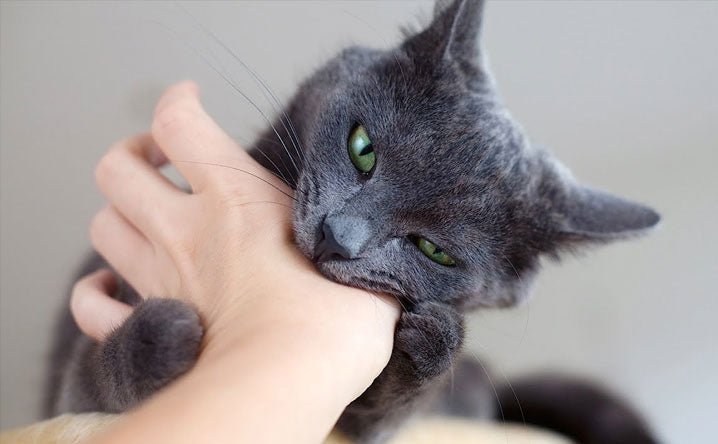Why Is My Cat Biting Me When I Pet Her? Unveiling the Mystery
Does your cat suddenly switch from purring to biting when you’re giving her a gentle pet? You’re not alone, and you might be wondering why this happens. Understanding your feline friend’s behavior can be both fascinating and perplexing. Why Is My Cat Biting Me When I Pet Her? Cats have their own unique ways of communicating, and sometimes, a bite is their way of sending a message. By delving into the reasons behind this common behavior, you can transform these unexpected nips into a more harmonious interaction. Stay with us as we explore the intriguing reasons why your cat might bite when you pet her, and discover how you can foster a deeper connection with your furry companion. Credit: cats.com Common Reasons For Cat Biting Cats might bite during petting due to overstimulation or sensitive areas. They communicate through biting. Understanding their signals helps. Cats can be mysterious creatures, and their behaviors often leave us scratching our heads. One common conundrum is when your cat starts biting you while you’re petting her. This behavior, while puzzling, is usually rooted in a few understandable reasons. Understanding these reasons can help you create a more harmonious relationship with your feline friend. Let’s dive into the most common reasons why your cat might be biting you during petting sessions. Cats have a threshold for how much petting they can handle. After a certain point, they might feel overstimulated and react by biting. Think of it as your cat’s way of saying, “Enough, please!” Watch for signs like twitching tails or a change in purring. These can indicate she’s reaching her limit. Playfulness Sometimes, biting is just a playful gesture. Cats, especially younger ones, often engage in mock hunting. Your hand might resemble a toy or prey in their eyes. Consider using a toy to redirect this playful energy. It can save your hands from those sharp little teeth. Discomfort Or Pain Your cat might bite if she’s experiencing discomfort or pain. This could be due to a sore spot or underlying health issue. If biting is accompanied by unusual behaviors, a vet visit might be necessary. It’s always better to err on the side of caution. Territorial Instincts Cats are territorial animals. If she feels her space is being invaded or if she’s not in a mood for petting, a bite might be her way of asserting boundaries. Respect her space by giving her a break. You’ll find she appreciates the gesture and might come back for affection on her own terms. Communication Your cat might be trying to communicate something. A bite can be a signal of needing something — maybe food or a change in environment. Keep an eye on her overall behavior. This can provide clues about what she might need or want. Stress Or Anxiety Stress can lead to unexpected behaviors, including biting. Changes in the environment or routine can trigger anxiety in cats. Create a calm, stable environment for her. Familiarity can help reduce stress and biting incidents. Understanding these common reasons can transform your relationship with your cat. Have you noticed any specific triggers for your cat’s biting? Addressing them can lead to a happier, more peaceful petting experience. Overstimulation Many cat owners face a puzzling behavior: their cats bite when petted. This unexpected reaction often stems from overstimulation. Cats have sensitive bodies, and petting can sometimes overwhelm them. Understanding this can help improve your interaction with your feline friend. Signs Of Sensory Overload Cats give subtle signs before biting. Watch for twitching tails, flattened ears, or dilated pupils. These indicate your cat is nearing its limit. Sudden hissing or growling also signals discomfort. Recognizing these signs can prevent unwanted behavior. How To Prevent Overstimulation Start by petting your cat gently. Short, light strokes are best. Limit petting sessions to a few minutes. Pause if your cat shows signs of distress. Offer breaks between sessions to let your cat relax. Respect their boundaries to maintain a happy relationship. Provide toys and activities to engage your cat’s mind. This reduces the chance of overstimulation. Use interactive toys that mimic prey. These distract and entertain your cat. A well-exercised cat is less likely to react negatively. Communication And Boundaries Cats have their unique way of communicating. Sometimes, this leads to confusion when they bite while being petted. Understanding their signals can help us respect their boundaries. This fosters a stronger bond between you and your feline friend. Understanding Cat Signals Cats use body language to express feelings. Watch their tail. A twitching tail often means irritation. Ears are another signal. Flattened ears can indicate discomfort or annoyance. Pay attention to their eyes. Dilated pupils may signal excitement or fear. Recognizing these signals helps you understand your cat better. It can prevent unwanted biting during petting sessions. Learn the subtle signs your cat shows. This will enhance your interaction and build trust. Respecting Personal Space Every cat has personal space needs. Some enjoy long petting sessions. Others prefer short, gentle strokes. Respect your cat’s comfort zone. If they pull away, give them space. This shows you respect their boundaries. Allow your cat to initiate contact. Let them approach you for affection. This makes them feel secure and understood. Creating a safe environment encourages positive interaction. It reduces stress and unwanted biting. Playful Behavior Cats often bite when being petted due to overstimulation. Their sensitive skin can become overwhelmed with too much contact. Understanding these signals can help prevent unexpected nips during cuddle time. Cats often bite during petting due to playful behavior, a natural instinct that can sometimes be misunderstood. This playful nipping is a way for your feline friend to interact and engage with you. However, it’s important to identify the difference between playful biting and aggression to ensure a happy and healthy relationship with your cat. Distinguishing Play From Aggression Cats may bite as part of their play, mimicking hunting behaviors. Look for body language cues like relaxed ears, a playful stance, and purring. These signals indicate … Read more

